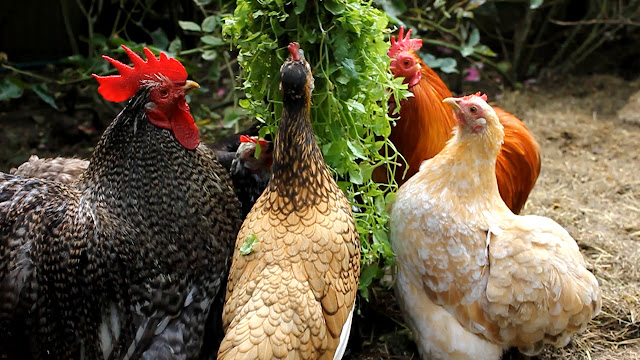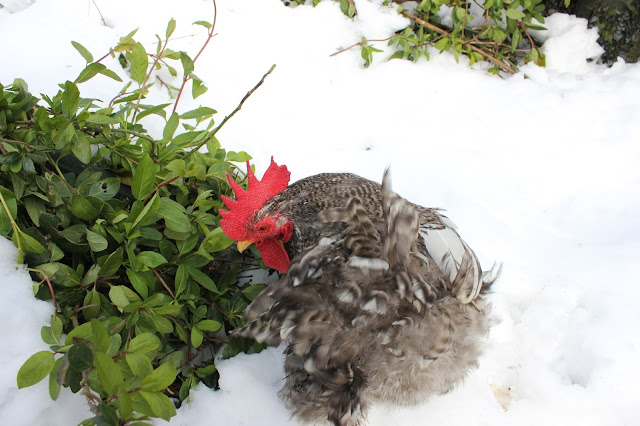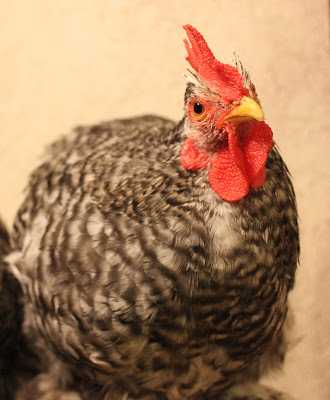These are our little
Cochins photographed the day after they were hatched I always like to get chicks outside but we had terrible weather that day; storms with occasional 'sunny spells'. An easy improvised run is a cardboard box with the bottom folded back. It keeps the chicks near the mother so they can easily get under her if cold and provides an all round shelter against the wind. If the grass is too damp, I just let them out inside the cardboard box as they then get a first dose of very necessary Vitamin D3 from the action of the UVB (short-shadow) sunlight. Later in the afternoon the wind went down and they were able to explore.
 The Cochin like all ancient breeds are excellent foragers and quickly become a vital part of any garden, keeping down weeds and pests. And as not all of the Cochin Craze story was 'spin', once they have gained your trust, both males and females can become tame and friendly. If you have a forest
garden like ours, where the birds are free to roost in trees at night, then the Cochin, although not great flyers, are great climbers, so they do very well in a wooded environment. They are also, obviously with their abundant plumage, an excellent breed to have in cold climates
The Cochin like all ancient breeds are excellent foragers and quickly become a vital part of any garden, keeping down weeds and pests. And as not all of the Cochin Craze story was 'spin', once they have gained your trust, both males and females can become tame and friendly. If you have a forest
garden like ours, where the birds are free to roost in trees at night, then the Cochin, although not great flyers, are great climbers, so they do very well in a wooded environment. They are also, obviously with their abundant plumage, an excellent breed to have in cold climatesHowever, they are also quick witted and adaptable so easily find shade in the heat.
The Strong Silent Type
Unlike many of the other rare heritage breeds we have here, Cochins are less vocal, and communicate more through body language. In my experience, this can be very physical; jumping up, pecking or pulling at clothes or perching on my knee willing me telepathically to understand want they want. I have a bantam Cochin, 'Panda', who likes to eat her breakfast alone. She remains roosting in the outbuilding where she sleeps until I lift her off and put her near a food bowl by herself. You might think that is strange but as a small hen in a largish flock she knows that to get her share of food she can rely on me.Many of my Cochins exhibit this body language and so do our fantail pigeons. I can usually interpret to some extent what they mean and find a solution. Poultry trusting the keeper as an arbitrator/provider, need to communicate basic needs:- I want food, someone is; in my nest box, stealing nesting materials, on my place on the roost, etc.,. Of course as we really know so little of the thoughts of birds and animals, at best this is guess work but in general the more we engage with our flock the better our understanding.
Me and my empathy, courtesy of Panda
Although sometimes they can be determined and independent of the flock, if you bring up Cochins together they will, being of similar temperament, tend to remain as a cohesive group. Similarly, with certain individual birds it can take some time to fully gain their trust.

Cochins, like elephants, never forget, particularly when they have been helped in some way. We hatched a trio of Columbian Cochins a couple of years after we arrived to live permanently in France. I was not aware at the time but my first hens, two Ardenners I was given as a gift, had brought scaly leg mite with them from their previous flock. This transferred to my Columbian Cochin cockerel/rooster and because of his extra feathery feet, these parasites took hold even before I was aware of them. When I did finally understand and treated his feet, 'Snowman' who had been rather offhand with us since a juvenile, became inseparable and as he got older was always hanging about the workshop rather than hanging out with the flock.
All Pluses and Preventable Minuses
Cochins have little stubby wings and don't fly well but my can they jump. If you are thinking of them for a forest garden then know that they can climb very well and also that they are not afraid to experiment in climbing and jumping techniques to reach safe roosting heights.
The only potential minus for Cochins is their feathery feet. These can get really water logged and muddy in heavy soils like ours but we can work around that by providing rain shelters and walkways.
The other more serious aspect is that you can miss noticing a proliferation of scaly leg mite, which can cause foot damage if left unattended. Cochins also seems more likely to transferring scaly leg mite to the face. You should check over your Cochins' face, in particular, around the ear covers. This seems to me yet another case for symbiotic and holistic poultry keeping. Give your Cochins a hug, it'll do your heart good and also give you a chance to check feet and face.
Are you ready to order some hatching eggs?
I hope it will also convince you to add some of these fascinating birds to your flock. In the next article in this series I will be looking at Cochins as mothers, fathers and the importance of family bonds.
Thanks for dropping by and do feel free to share experiences or ask for further information in the comment section. If you have enjoyed this piece and found it
useful think about sharing it with your family and friends, on social media and also maybe about joining this blog
and/or subscribing to my Youtube channel or even supporting us on
Patreon or
It all helps to keep me going!
Until next time, all the very best from Normandie! Sue
© 2018 Sue Cross
RELATED ARTICLES
Cochin Craze 4 - Incredible Cochin Mothers & Family Bonds
Cappuccino was with her quail for over 3 months, which gave her so much
time with them and for them in turn to appreciate what it was to...read more
 The Cochin Craze 1 - A Story of Addiction
The Cochin Craze 1 - A Story of Addiction
These fluffy bundles, which I have been raising
for ten years have a unique and fascinatingly terrible history,
involving bloody wars, tea, silver and above all opium. A three part
article on the chicken version of Tulip Mania and my own Cochin..read more
 The Cochin Craze 2. From Craze to Mania
The Cochin Craze 2. From Craze to Mania
'The
introduction of these fowls...was a memorable event in the history of
poultry; since they undoubtedly awakened a startling "mania" which was,
calmly considered, one of the most curious phenomena of the nineteenth
century'...read more
 The Cochin Craze 1 - A Story of Addiction
The Cochin Craze 1 - A Story of Addiction
These fluffy bundles, which I have been raising
for ten years have a unique and fascinatingly terrible history,
involving bloody wars, tea, silver and above all opium. A three part
article on the chicken version of Tulip Mania and my own Cochin..read more
 The Cochin Craze 2. From Craze to Mania
The Cochin Craze 2. From Craze to Mania
'The
introduction of these fowls...was a memorable event in the history of
poultry; since they undoubtedly awakened a startling "mania" which was,
calmly considered, one of the most curious phenomena of the nineteenth
century'...read more














Hi Sue, please help me! Got a few five-week-old quails, raised on commercial food. Put some June bugs with them, after a few hours two of the quail had figured out what to do and ate them. They ignore ants though. Some success with cucumber and tomato, but they ignore lettuce and grated carrot. Saw them nibbling at a birch fringe, brought them a couple handfulls, everyone pecked at them and "bathed" in them. Same with half finished compost. They do peck at something in compost that is invisible to the human eye, but I am worried that I am going to accidentally starve them. I still gave them a little commercial food the seller left me. Got some organic whole wheat sprouting for them that is going to be ready in a couple of days.
ReplyDeleteMy husband is amused at the whole situation but I am definitely not. Sorry for bothering you, but any idea/suggestion on how to transition them safely to real food would be so appreciated... Thank you! Anna
Hi Anna, I am so sorry I only just found your comment. For some reason, I no longer get any notifications of comments by email and I didn't realise that this was the case until today. It will take your quail a little while to understand what is food and what isn't but they will certainly eat enough by testing and trying things. They are intelligent birds and I've always found that every quail I've raised has gone crazy for hard-boiled egg so I would try with that as it is a great all round food. Vegetation takes some time, as they seem to pick and choose, once you have them bonded to you, you can then free-range them as I did in one of my latest videos and then they can have a wide range of foods to explore. I think what you might find also and I did certainly with the quail I transitioned from caged to organic, was that they are highly deficient in non-edible fibre and minerals. I think what your quail maybe doing is eating all sorts of debris on top of and in the soil to rectify that. Mine ate volumes of what looked like earth at the beginning and as you are no doubt aware, birds have no way of obtaining gut flora before hatch, they need to create that themselves and one of the main ways is by creating a suitable environment from eating humus on/in the soil. It may therefore be that with the new foods the quail automatically crave the substances to create enzymes to help digest them as well as grit? I'm hoping things worked out by now and am so sorry for missing your comments. Some things with birds are definitely learned though, I know when I rehomed my first fantail pigeons that they would eat little greenery although they had the whole garden open to them. However, when I bought a new fantail at an exhibition, the others followed him around the garden and I saw him actually showing them what to eat. Your representing foodstuffs to them though will be a signal to them to try and eventually this will I believe happen. You will already be in the position of 'head quail' in the flock or rather 'drift', an archaic but beautiful description of these wonderful birds. Hope this helps and get back to me and let me know how things worked out. I am very interested. All the very best from sunny Normandie, Sue
DeleteHi Sue I love your videos and blog post. I have a question about paired off quail I have 7 hens and 7 males they all seem to get on fine all except for one male that will scare away the hens off the food plate ( I feed them oats, sprouted grain and lettuce) I have a 32 ft.² coop/run do you I think that is too many quail for the amount of space? I also would like to keep some of their offspring and think this would make it way too crowded. All the best. Jake
ReplyDeleteThis comment has been removed by the author.
ReplyDeleteSorry for the typo ;)
ReplyDeleteSo I definitely will have to get rid of 1 male because he is now attacking most of my quail especially a little tuxedo named cappuccino (named after your Frizel Hen) and a little golden quail named Spice, but I did just add them to the flock yesterday so is he just establishing a packing order?
ReplyDeleteThis comment has been removed by the author.
DeleteAnd will 6 males still be too many. will too many males interfere with nesting/brooding thanks. Jake. and sorry if I am being annoying ; )
ReplyDelete